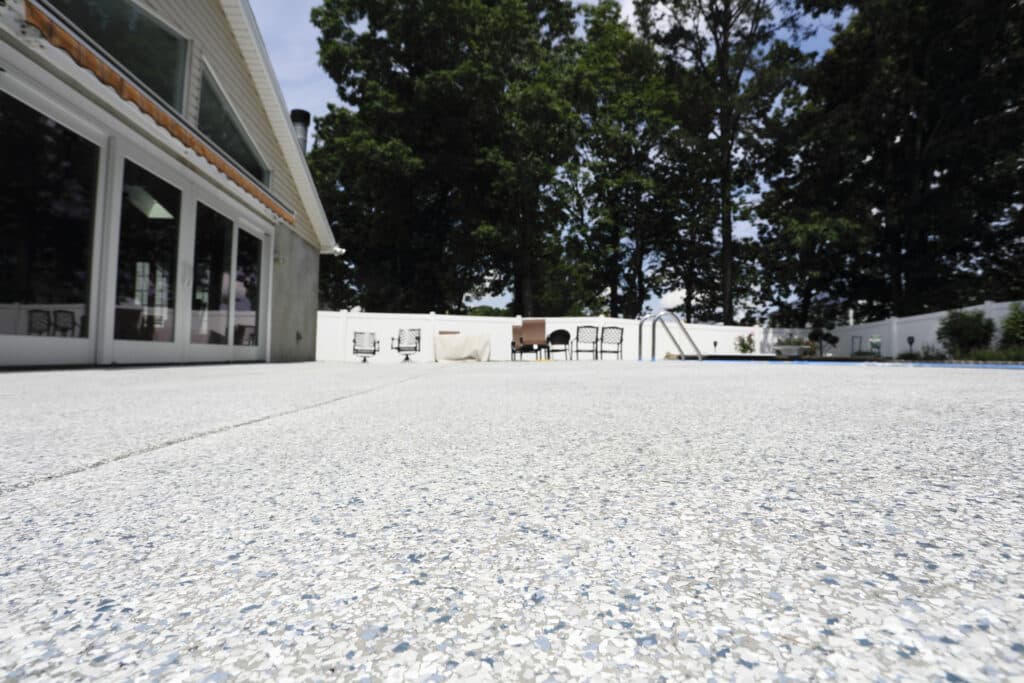If we compare the pool decking options, it is essential to consider the material you want in your design. Decorative concrete provides many looks you like, but in a cost-effective way. It also combines design flexibility and beauty with durability and strength.
The best material to use around the pool
When you are trying to weigh the pool deck materials you are considering, consider the factors like durability, maintenance, safety, budget, and how to fit your landscape and home. While concrete is not the only player in the game, it also offers many advantages that other pool deck materials can’t match, especially when it comes to versatility.
Concrete is tested during the face-off against some tough competition, including tile, brick, pavers, and natural stone. Although all these materials have a few pros and cons, we believe concrete is the clear winner in the categories below:
Slip resistance
Good traction is essential on the pool deck surface, and slip resistance is a high priority. All the pool deck materials can become slippery when wet, especially tile, but with concrete, there are several ways to improve the surface traction without detracting from the decorative appearance. It also includes using the exposed or broomed aggregate finishes, putting down textured overlay, or mixing clear plastic grit in the sealer before applying it.
Heat reflectivity
Compared to the dark-colored tile or brick pool decks which can become hot to touch after baking in the sun, concrete reflects solar radiation and is more comfortable on bare feet. There are also decorative toppings for concrete that can significantly lower surface temperatures.
Affordable
While pool decks are made of bricks, pavers, flagstones or have a great aesthetic appeal, they can be costly to install because of the labor required to place each unity individually. Many homeowners find it cheap to pour concrete and apply the pattern instead of hauling and placing paving units by hand. In case of a tight budget, try to achieve impressive results by mixing stamped concrete with fields of less-expensive plain concrete. You can also look for the best concrete coating company for excellent yet cheap services.
Design options
Only decorative concrete gives you the ability to select any surface, color, size, and shape treatment for your pool deck – from plain broom-finished concrete to imprinted or exposed aggregate patterns that mimic stone, brick, or tile. You can also match and mix decorative treatments like combining stained concrete with an imprinted or stenciled border to enhance a colored overlay with engraved or saw cut patterns.
Ease of maintenance
Paving units and bricks can shift over time that requires replacement or releveling. The joints between paving units are also needed to be refilled with sand. It helps to keep up and prevent weed growth. Poured concrete eliminates all these issues, and you need to give them occasional cleaning and resealing to maintain its appearance.
Finish options for a decorative concrete pool deck
The decorative concrete gives an ability to select color, size, shape, and surface treatment for your deck-from plain broom-finished concrete to exposed aggregate. It also helps with imprinted patterns that mimic wood, natural stone, and even brick. You can also match and mix decorative treatments, such as combining stained concrete with an imprinted or stenciled border or enhancing engraved patterns or colored overlay with a saw cut. You can also design your concrete pool deck to blend in with your home’s exterior surrounding landscape and façade or make it the focal point of your backyard.
Stamped concrete
Flagstone, brick, or natural slate is ideal for creating pool decks. When colored with dry-shake color hardeners or stains, stamped concrete looks identical to the natural stone but is easy to maintain and install.
Colored concrete
The most popular methods to color concrete pool decks or other exterior concrete are dry-shake hardeners, integral color, and chemical stains.
Stenciled concrete
Stenciling a concrete pool deck could be a great alternative to decorative stamping while permitting similar design flexibility. Using disposable paper stencils, rubber stamps, or stone patterns in fresh concrete is easy.
Rock-Salt Finished concrete
A rock salt finish is a low-cost, easy method to add subtle texture and slip resistance to colored or plain concrete pool decks.
Exposed aggregate
Exposing the aggregate in concrete produced a pebble-like finish, well-suited for pool deck surfaces because it is high slips resistant.
Broom or Brushed Finish
A broom or brushed finish will add a slip-resistant texture to your pool deck. A brushed finish is achieved by running a broom over a new or freshly poured coated concrete surface.
Conclusion
The given above are the things to consider when you want to consider choosing the pool deck flooring. Transylvania Concrete Coatings offers a fantastic floor coating service with one-day installations. You can contact us if you are looking for the best pool deck coatings in NJ.

